FORD KUGA 2010 1.G Owners Manual
Manufacturer: FORD, Model Year: 2010, Model line: KUGA, Model: FORD KUGA 2010 1.GPages: 226, PDF Size: 8.07 MB
Page 101 of 226
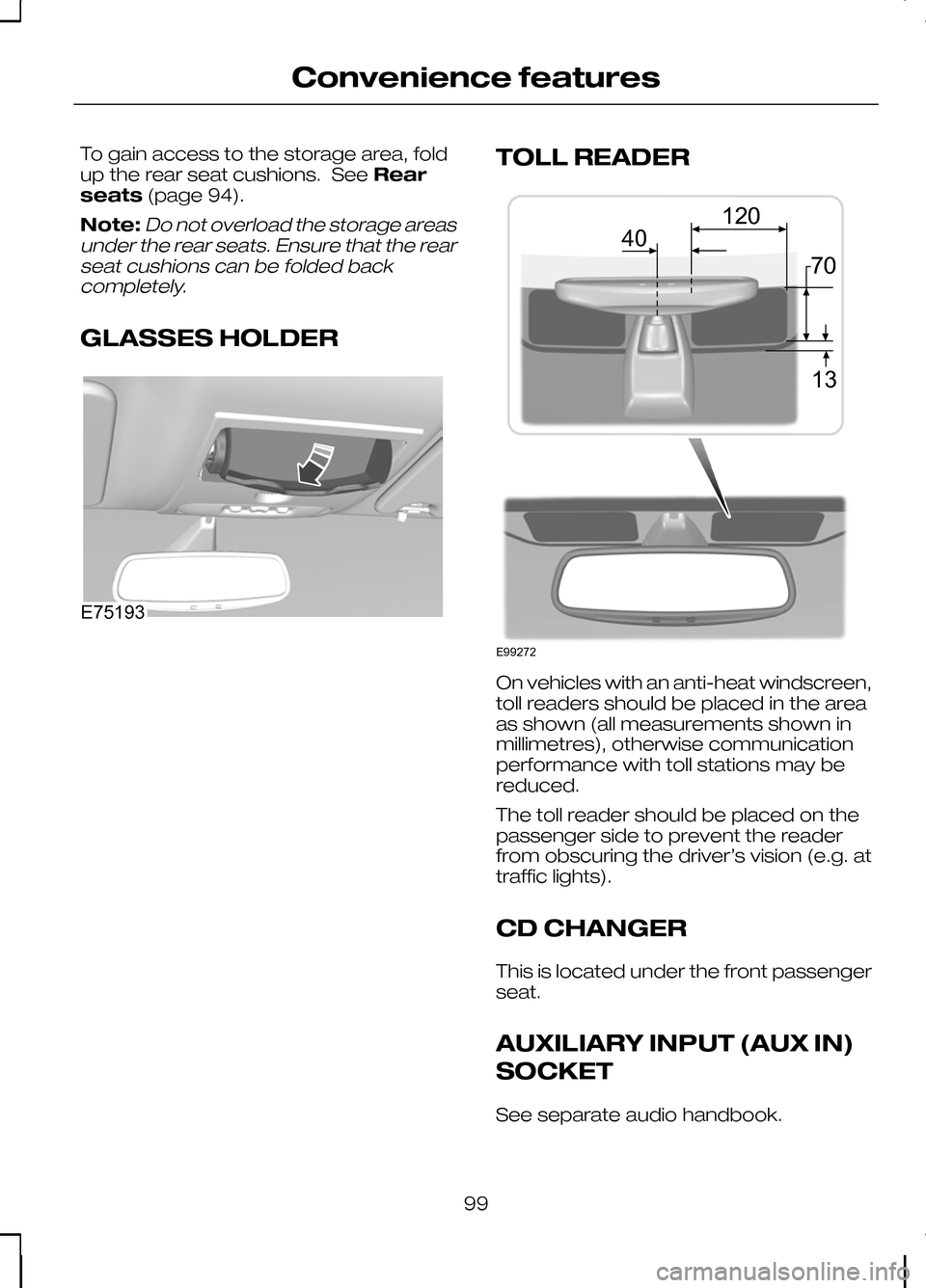
To gain access to the storage area, fold
up the rear seat cushions. See
Rear
seats (page 94).
Note:Do not overload the storage areas
under the rear seats. Ensure that the rear seat cushions can be folded backcompletely.
GLASSES HOLDER TOLL READER
On vehicles with an anti-heat windscreen,
toll readers should be placed in the area
as shown (all measurements shown in
millimetres), otherwise communication
performance with toll stations may be
reduced.
The toll reader should be placed on the
passenger side to prevent the reader
from obscuring the driver’s vision (e.g. at
traffic lights).
CD CHANGER
This is located under the front passenger
seat.
AUXILIARY INPUT (AUX IN)
SOCKET
See separate audio handbook.
99
Convenience featuresE75193 E99272401370120
Page 102 of 226
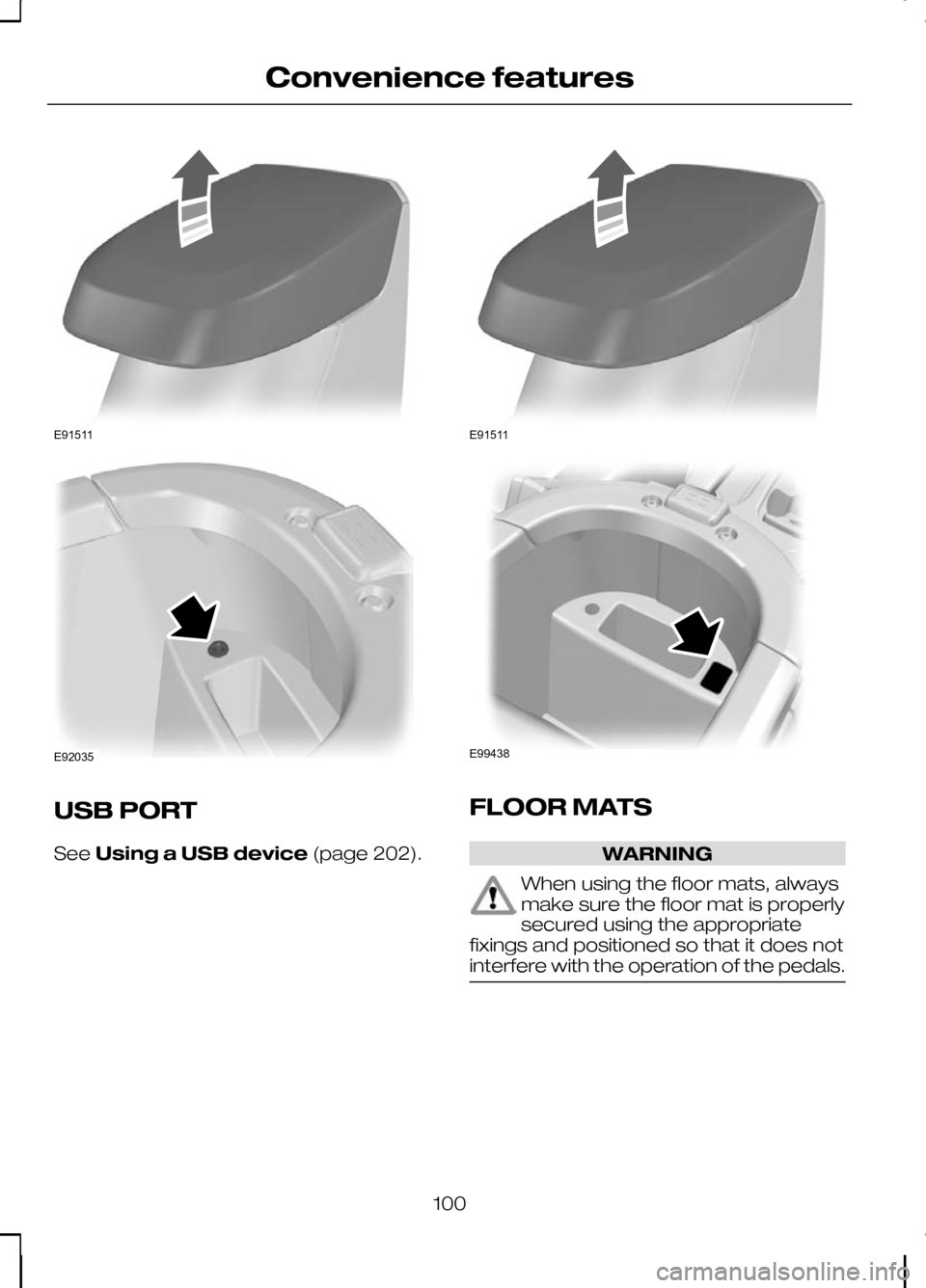
USB PORT
See
Using a USB device (page 202). FLOOR MATS
WARNING
When using the floor mats, always
make sure the floor mat is properly
secured using the appropriate
fixings and positioned so that it does not
interfere with the operation of the pedals. 100
Convenience featuresE91511 E92035 E91511 E99438
Page 103 of 226
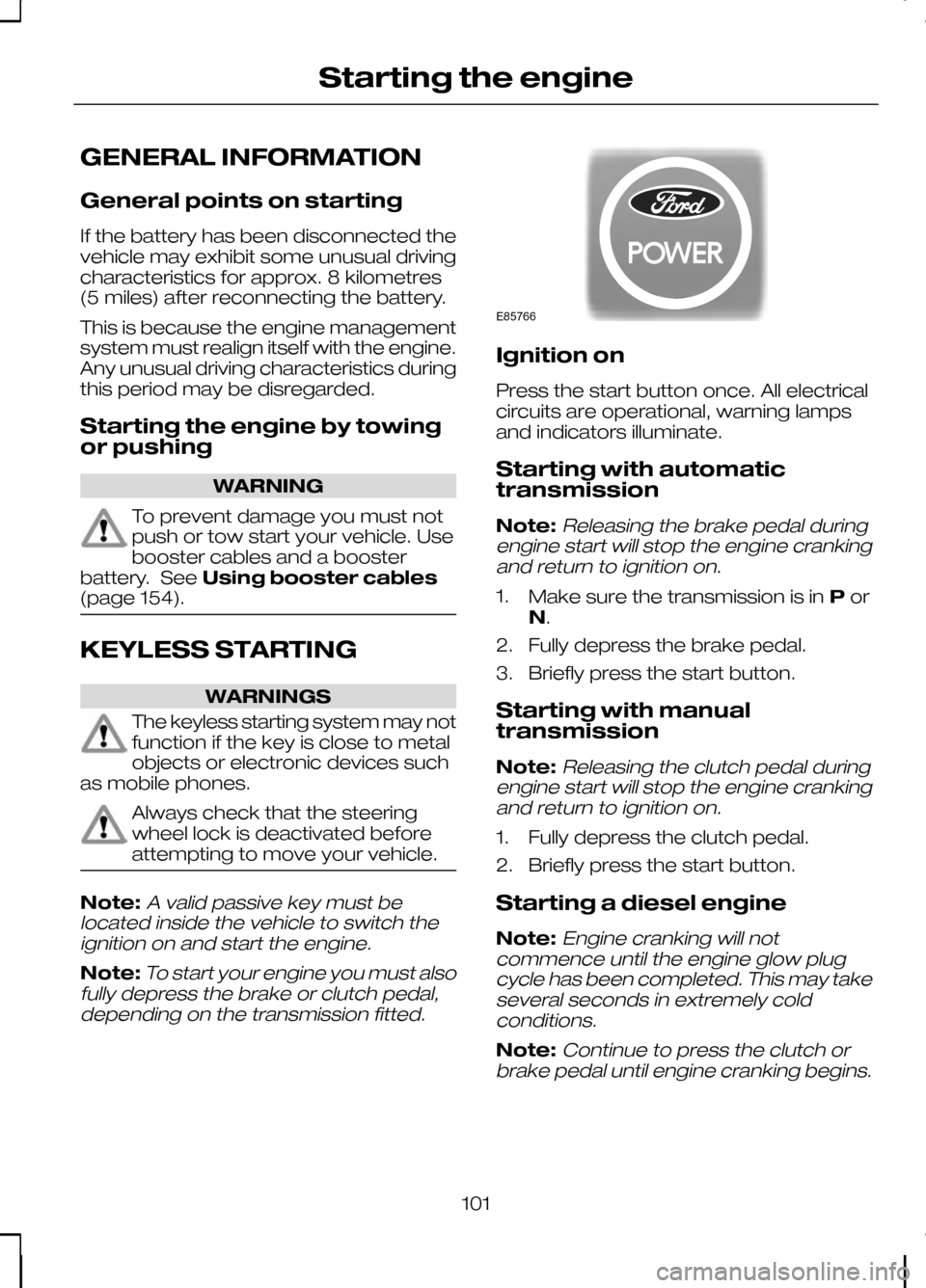
GENERAL INFORMATION
General points on starting
If the battery has been disconnected the
vehicle may exhibit some unusual driving
characteristics for approx. 8 kilometres
(5 miles) after reconnecting the battery.
This is because the engine management
system must realign itself with the engine.
Any unusual driving characteristics during
this period may be disregarded.
Starting the engine by towing
or pushing
WARNING
To prevent damage you must not
push or tow start your vehicle. Use
booster cables and a booster
battery. See Using booster cables
(page 154). KEYLESS STARTING
WARNINGS
The keyless starting system may not
function if the key is close to metal
objects or electronic devices such
as mobile phones. Always check that the steering
wheel lock is deactivated before
attempting to move your vehicle.
Note:A valid passive key must be
located inside the vehicle to switch the ignition on and start the engine.
Note:To start your engine you must also
fully depress the brake or clutch pedal, depending on the transmission fitted. Ignition on
Press the start button once. All electrical
circuits are operational, warning lamps
and indicators illuminate.
Starting with automatic
transmission
Note:
Releasing the brake pedal during
engine start will stop the engine cranking and return to ignition on.
1. Make sure the transmission is in Por
N.
2. Fully depress the brake pedal.
3. Briefly press the start button.
Starting with manual
transmission
Note:
Releasing the clutch pedal during
engine start will stop the engine cranking and return to ignition on.
1. Fully depress the clutch pedal.
2. Briefly press the start button.
Starting a diesel engine
Note:
Engine cranking will not
commence until the engine glow plug cycle has been completed. This may takeseveral seconds in extremely coldconditions.
Note:Continue to press the clutch or
brake pedal until engine cranking begins.
101
Starting the engineE85766
Page 104 of 226
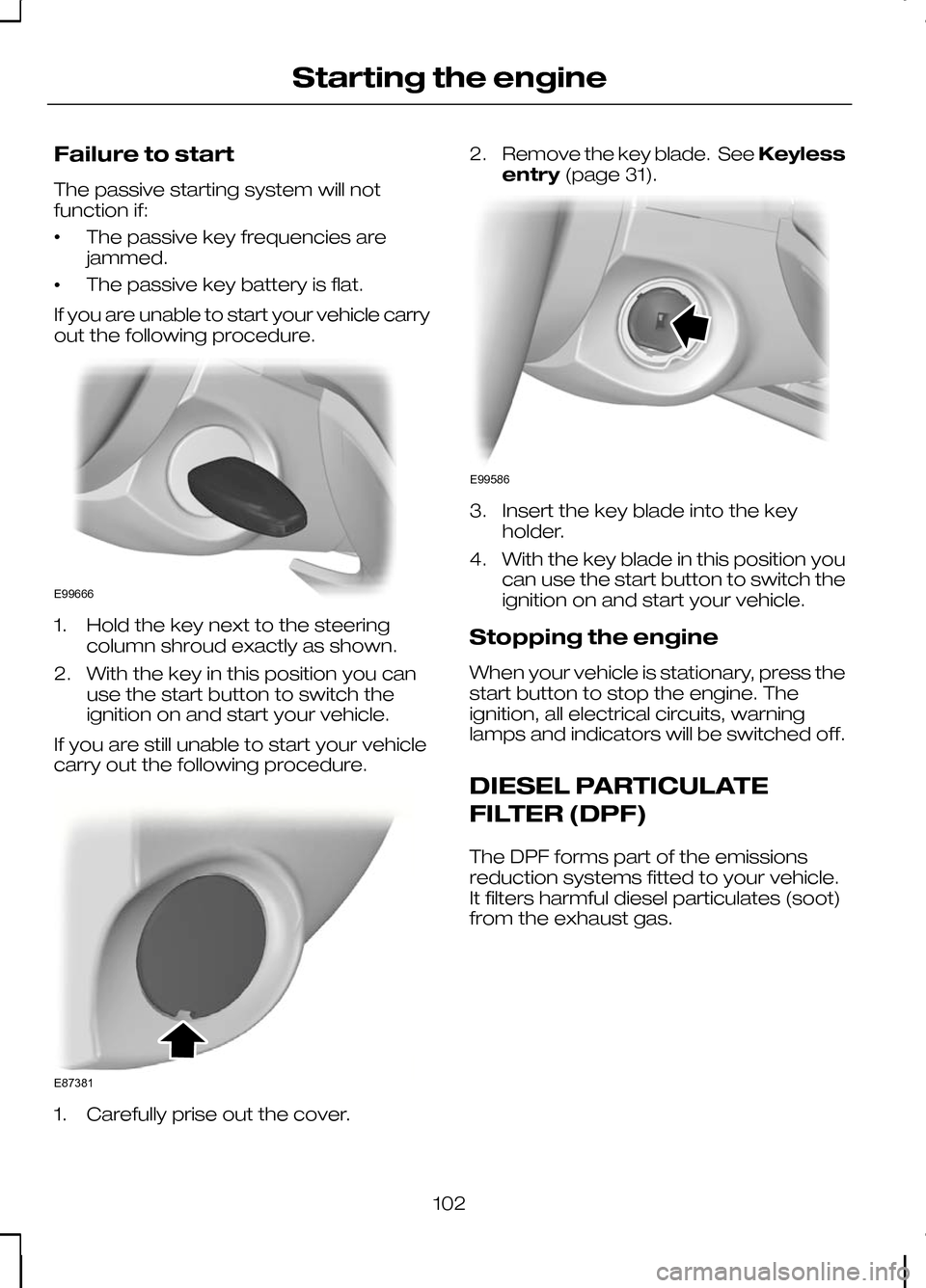
Failure to start
The passive starting system will not
function if:
•
The passive key frequencies are
jammed.
• The passive key battery is flat.
If you are unable to start your vehicle carry
out the following procedure. 1. Hold the key next to the steering
column shroud exactly as shown.
2. With the key in this position you can use the start button to switch the
ignition on and start your vehicle.
If you are still unable to start your vehicle
carry out the following procedure. 1. Carefully prise out the cover. 2.
Remove the key blade. See Keyless
entry (page 31). 3. Insert the key blade into the key
holder.
4. With the key blade in this position you can use the start button to switch the
ignition on and start your vehicle.
Stopping the engine
When your vehicle is stationary, press the
start button to stop the engine. The
ignition, all electrical circuits, warning
lamps and indicators will be switched off.
DIESEL PARTICULATE
FILTER (DPF)
The DPF forms part of the emissions
reduction systems fitted to your vehicle.
It filters harmful diesel particulates (soot)
from the exhaust gas.
102
Starting the engineE99666 E87381 E99586
Page 105 of 226
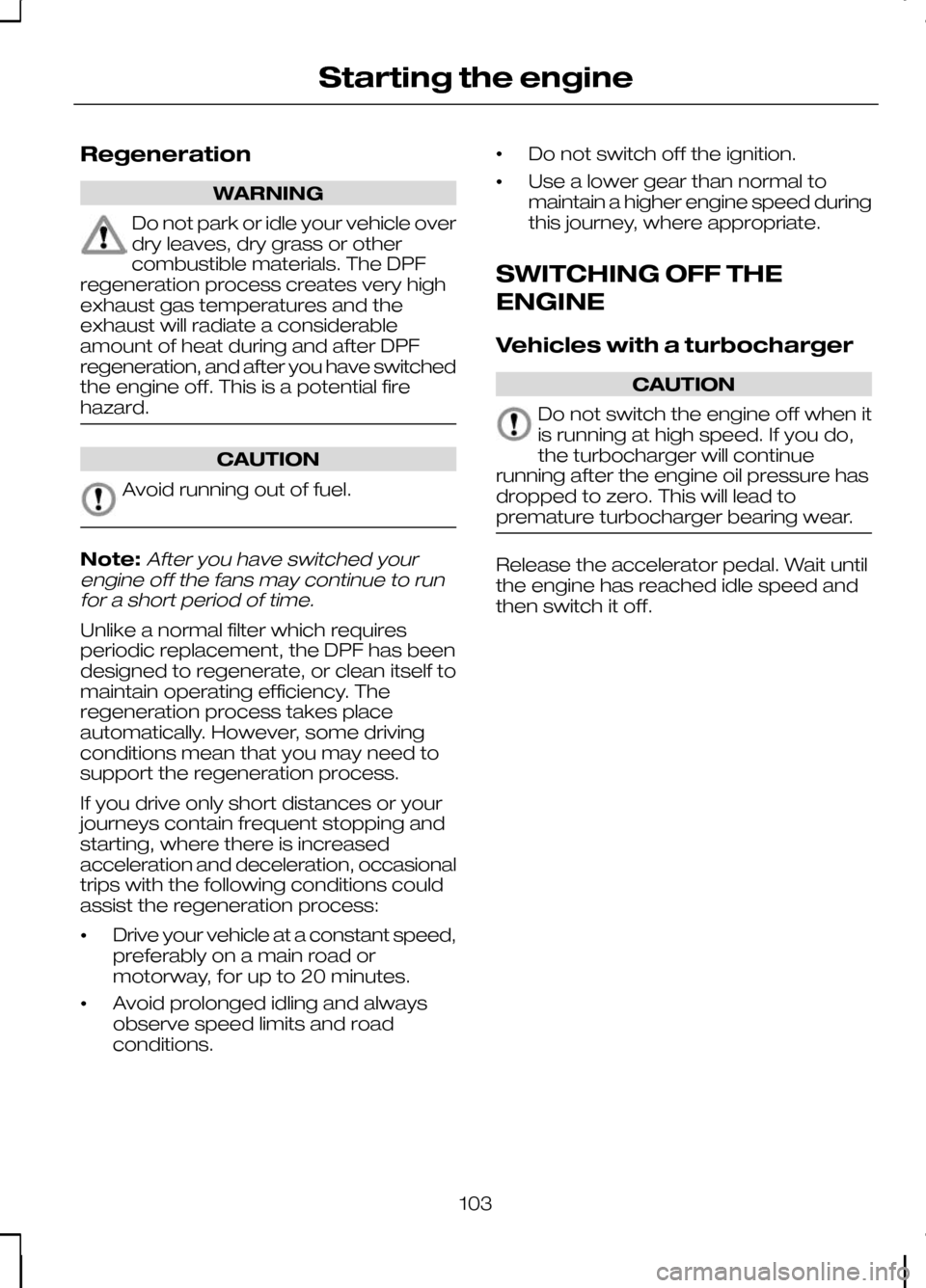
Regeneration
WARNING
Do not park or idle your vehicle over
dry leaves, dry grass or other
combustible materials. The DPF
regeneration process creates very high
exhaust gas temperatures and the
exhaust will radiate a considerable
amount of heat during and after DPF
regeneration, and after you have switched
the engine off. This is a potential fire
hazard. CAUTION
Avoid running out of fuel.
Note:After you have switched your
engine off the fans may continue to run for a short period of time.
Unlike a normal filter which requires
periodic replacement, the DPF has been
designed to regenerate, or clean itself to
maintain operating efficiency. The
regeneration process takes place
automatically. However, some driving
conditions mean that you may need to
support the regeneration process.
If you drive only short distances or your
journeys contain frequent stopping and
starting, where there is increased
acceleration and deceleration, occasional
trips with the following conditions could
assist the regeneration process:
• Drive your vehicle at a constant speed,
preferably on a main road or
motorway, for up to 20 minutes.
• Avoid prolonged idling and always
observe speed limits and road
conditions. •
Do not switch off the ignition.
• Use a lower gear than normal to
maintain a higher engine speed during
this journey, where appropriate.
SWITCHING OFF THE
ENGINE
Vehicles with a turbocharger CAUTION
Do not switch the engine off when it
is running at high speed. If you do,
the turbocharger will continue
running after the engine oil pressure has
dropped to zero. This will lead to
premature turbocharger bearing wear. Release the accelerator pedal. Wait until
the engine has reached idle speed and
then switch it off.
103
Starting the engine
Page 106 of 226
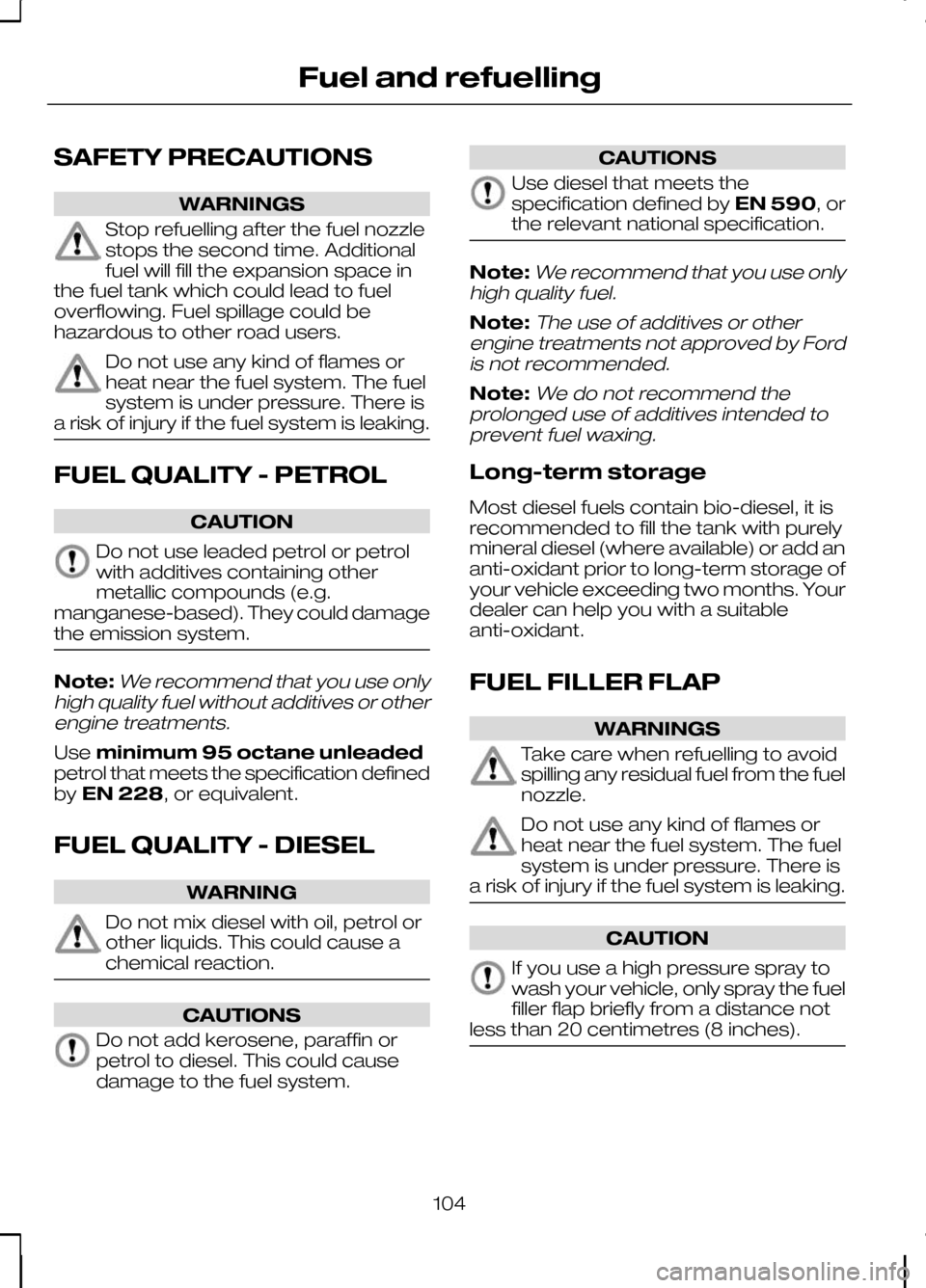
SAFETY PRECAUTIONS
WARNINGS
Stop refuelling after the fuel nozzle
stops the second time. Additional
fuel will fill the expansion space in
the fuel tank which could lead to fuel
overflowing. Fuel spillage could be
hazardous to other road users. Do not use any kind of flames or
heat near the fuel system. The fuel
system is under pressure. There is
a risk of injury if the fuel system is leaking. FUEL QUALITY - PETROL
CAUTION
Do not use leaded petrol or petrol
with additives containing other
metallic compounds (e.g.
manganese-based). They could damage
the emission system. Note:We recommend that you use only
high quality fuel without additives or other engine treatments.
Use minimum 95 octane unleaded
petrol that meets the specification defined
by EN 228, or equivalent.
FUEL QUALITY - DIESEL WARNING
Do not mix diesel with oil, petrol or
other liquids. This could cause a
chemical reaction.
CAUTIONS
Do not add kerosene, paraffin or
petrol to diesel. This could cause
damage to the fuel system. CAUTIONS
Use diesel that meets the
specification defined by
EN 590, or
the relevant national specification. Note:
We recommend that you use only
high quality fuel.
Note:The use of additives or other
engine treatments not approved by Ford is not recommended.
Note:We do not recommend the
prolonged use of additives intended to prevent fuel waxing.
Long-term storage
Most diesel fuels contain bio-diesel, it is
recommended to fill the tank with purely
mineral diesel (where available) or add an
anti-oxidant prior to long-term storage of
your vehicle exceeding two months. Your
dealer can help you with a suitable
anti-oxidant.
FUEL FILLER FLAP WARNINGS
Take care when refuelling to avoid
spilling any residual fuel from the fuel
nozzle.
Do not use any kind of flames or
heat near the fuel system. The fuel
system is under pressure. There is
a risk of injury if the fuel system is leaking. CAUTION
If you use a high pressure spray to
wash your vehicle, only spray the fuel
filler flap briefly from a distance not
less than 20 centimetres (8 inches). 104
Fuel and refuelling
Page 107 of 226
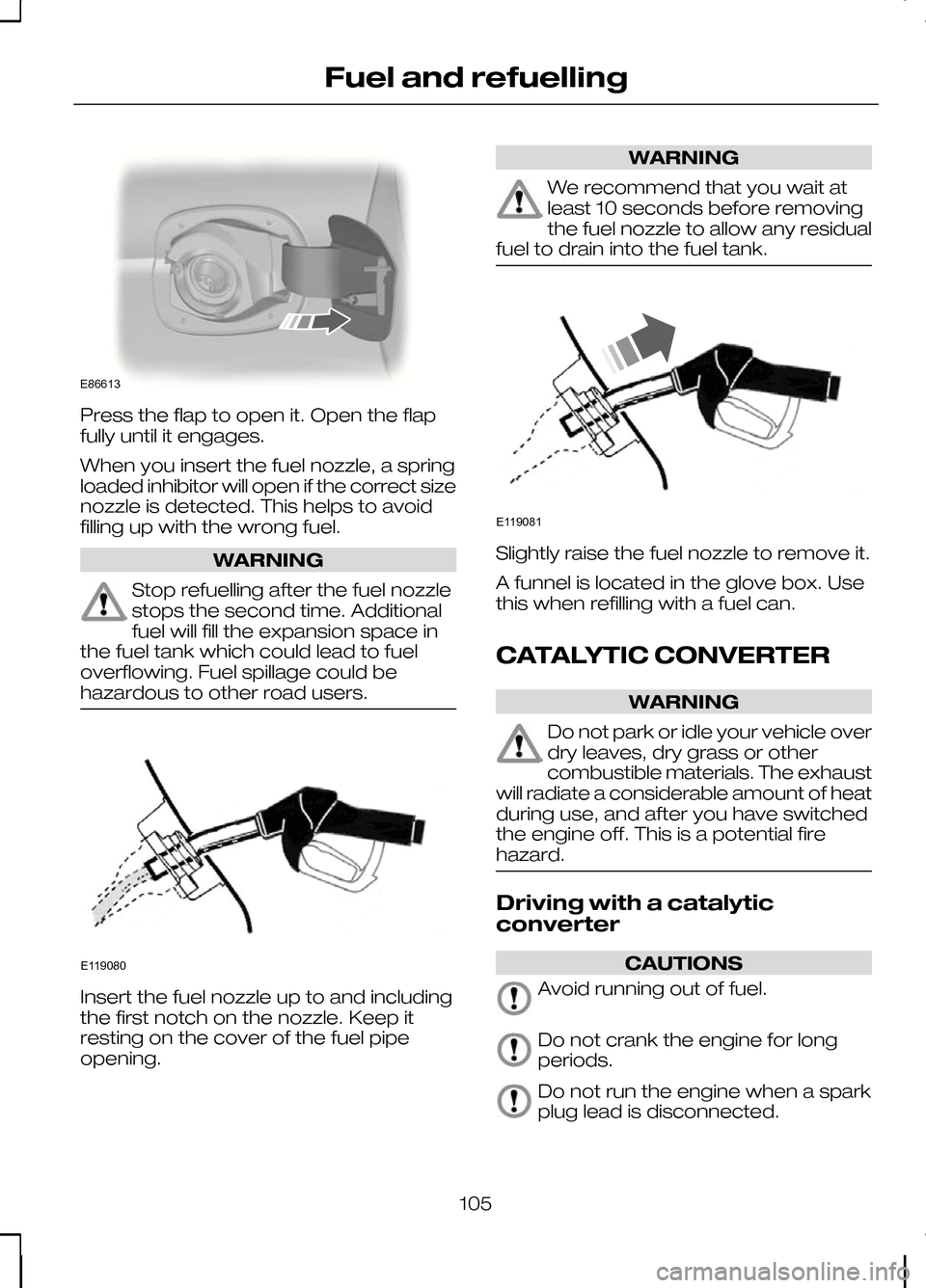
Press the flap to open it. Open the flap
fully until it engages.
When you insert the fuel nozzle, a spring
loaded inhibitor will open if the correct size
nozzle is detected. This helps to avoid
filling up with the wrong fuel.
WARNING
Stop refuelling after the fuel nozzle
stops the second time. Additional
fuel will fill the expansion space in
the fuel tank which could lead to fuel
overflowing. Fuel spillage could be
hazardous to other road users. Insert the fuel nozzle up to and including
the first notch on the nozzle. Keep it
resting on the cover of the fuel pipe
opening. WARNING
We recommend that you wait at
least 10 seconds before removing
the fuel nozzle to allow any residual
fuel to drain into the fuel tank. Slightly raise the fuel nozzle to remove it.
A funnel is located in the glove box. Use
this when refilling with a fuel can.
CATALYTIC CONVERTER
WARNING
Do not park or idle your vehicle over
dry leaves, dry grass or other
combustible materials. The exhaust
will radiate a considerable amount of heat
during use, and after you have switched
the engine off. This is a potential fire
hazard. Driving with a catalytic
converter
CAUTIONS
Avoid running out of fuel.
Do not crank the engine for long
periods.
Do not run the engine when a spark
plug lead is disconnected.
105
Fuel and refuellingE86613 E119080 E119081
Page 108 of 226
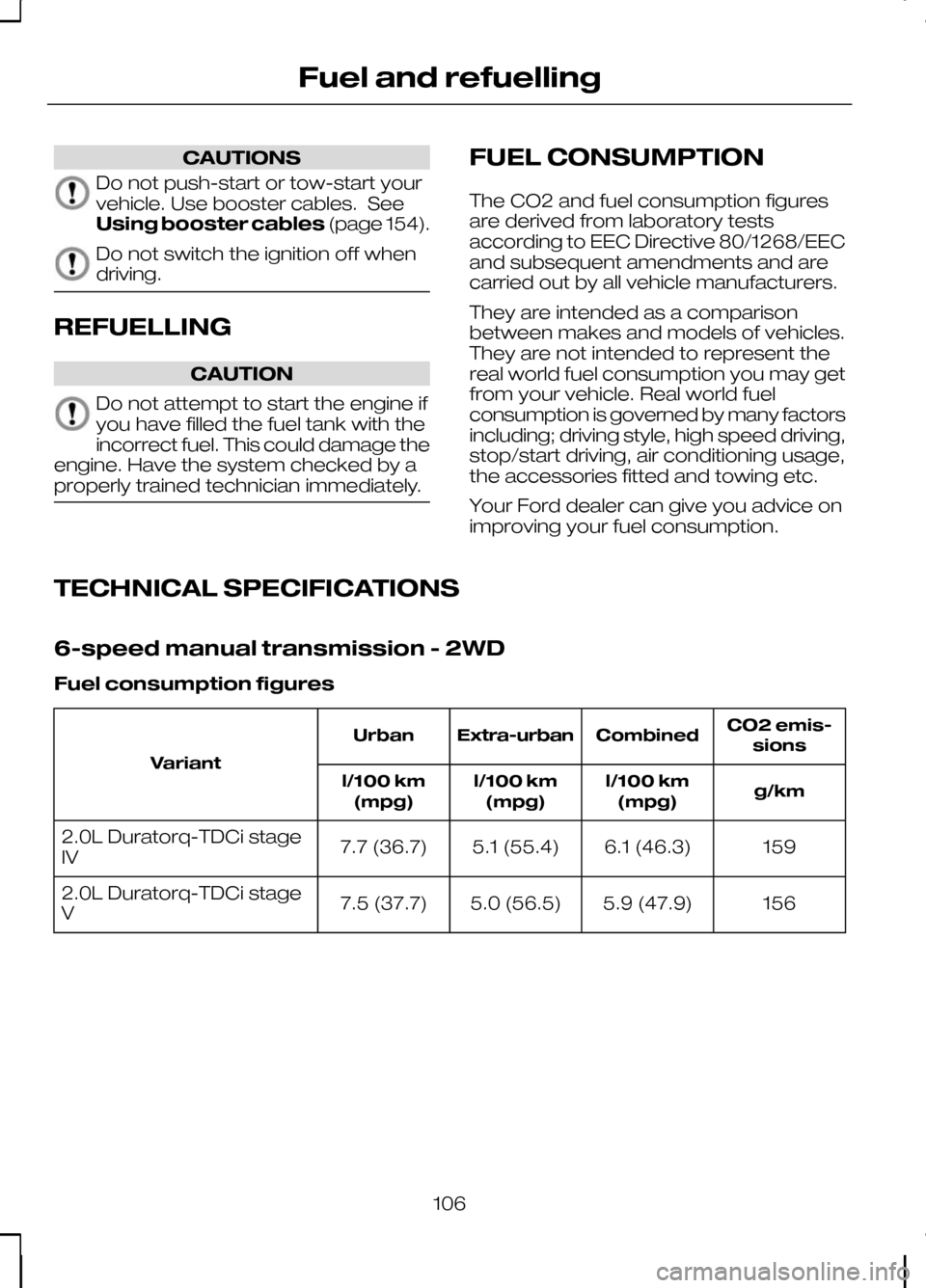
CAUTIONS
Do not push-start or tow-start your
vehicle. Use booster cables. See
Using booster cables
(page 154).Do not switch the ignition off when
driving.
REFUELLING
CAUTION
Do not attempt to start the engine if
you have filled the fuel tank with the
incorrect fuel. This could damage the
engine. Have the system checked by a
properly trained technician immediately. FUEL CONSUMPTION
The CO2 and fuel consumption figures
are derived from laboratory tests
according to EEC Directive 80/1268/EEC
and subsequent amendments and are
carried out by all vehicle manufacturers.
They are intended as a comparison
between makes and models of vehicles.
They are not intended to represent the
real world fuel consumption you may get
from your vehicle. Real world fuel
consumption is governed by many factors
including; driving style, high speed driving,
stop/start driving, air conditioning usage,
the accessories fitted and towing etc.
Your Ford dealer can give you advice on
improving your fuel consumption.
TECHNICAL SPECIFICATIONS
6-speed manual transmission - 2WD
Fuel consumption figures CO2 emis-
sions
Combined
Extra-urban
Urban
Variant g/km
l/100 km
(mpg)
l/100 km
(mpg)
l/100 km
(mpg)
159
6.1 (46.3)
5.1 (55.4)
7.7 (36.7)
2.0L Duratorq-TDCi stage
IV
156
5.9 (47.9)
5.0 (56.5)
7.5 (37.7)
2.0L Duratorq-TDCi stage
V
106
Fuel and refuelling
Page 109 of 226
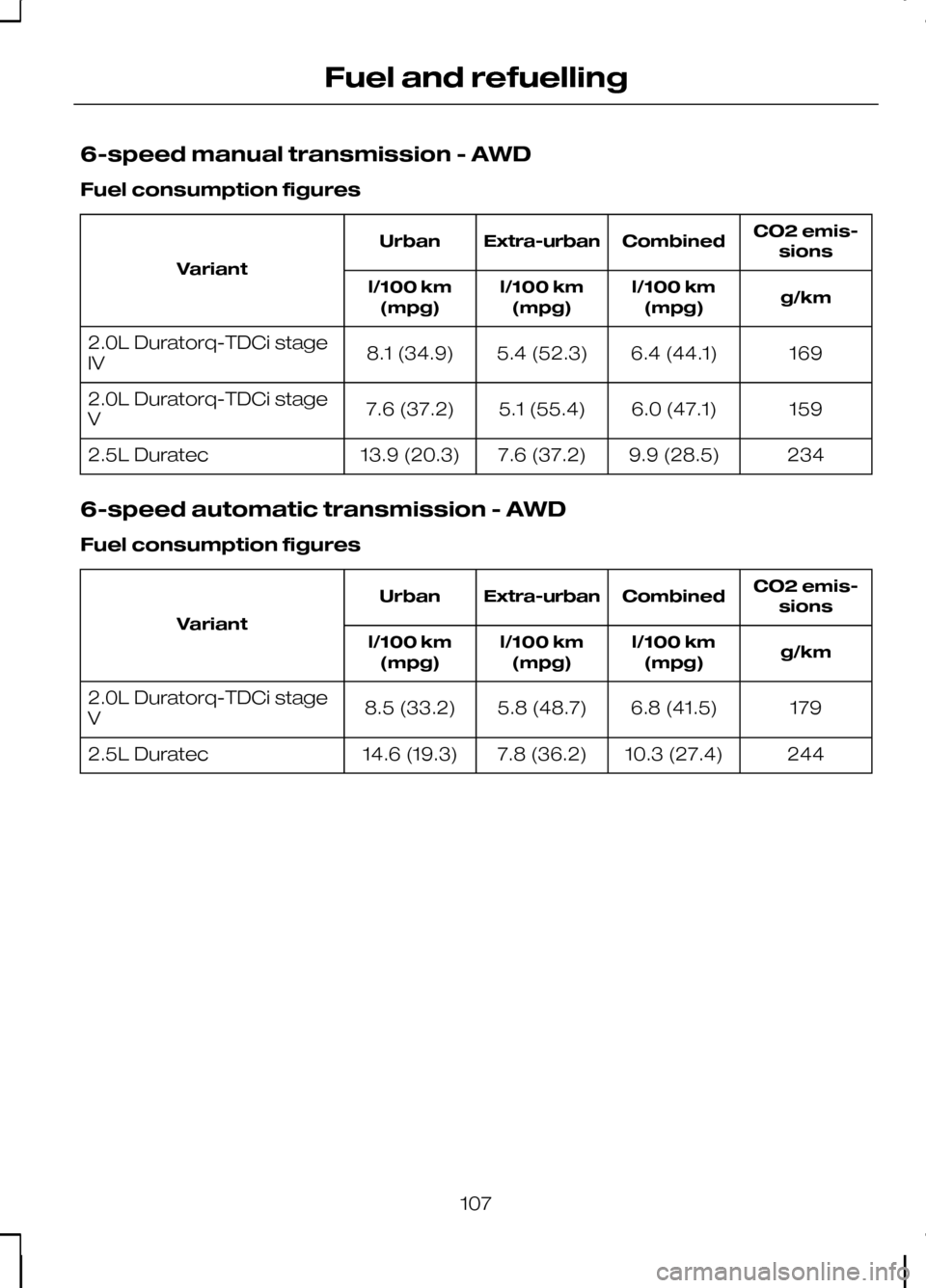
6-speed manual transmission - AWD
Fuel consumption figures
CO2 emis-
sions
Combined
Extra-urban
Urban
Variant g/km
l/100 km
(mpg)
l/100 km
(mpg)
l/100 km
(mpg)
169
6.4 (44.1)
5.4 (52.3)
8.1 (34.9)
2.0L Duratorq-TDCi stage
IV
159
6.0 (47.1)
5.1 (55.4)
7.6 (37.2)
2.0L Duratorq-TDCi stage
V
234
9.9 (28.5)
7.6 (37.2)
13.9 (20.3)
2.5L Duratec
6-speed automatic transmission - AWD
Fuel consumption figures CO2 emis-
sions
Combined
Extra-urban
Urban
Variant g/km
l/100 km
(mpg)
l/100 km
(mpg)
l/100 km
(mpg)
179
6.8 (41.5)
5.8 (48.7)
8.5 (33.2)
2.0L Duratorq-TDCi stage
V
244
10.3 (27.4)
7.8 (36.2)
14.6 (19.3)
2.5L Duratec
107
Fuel and refuelling
Page 110 of 226
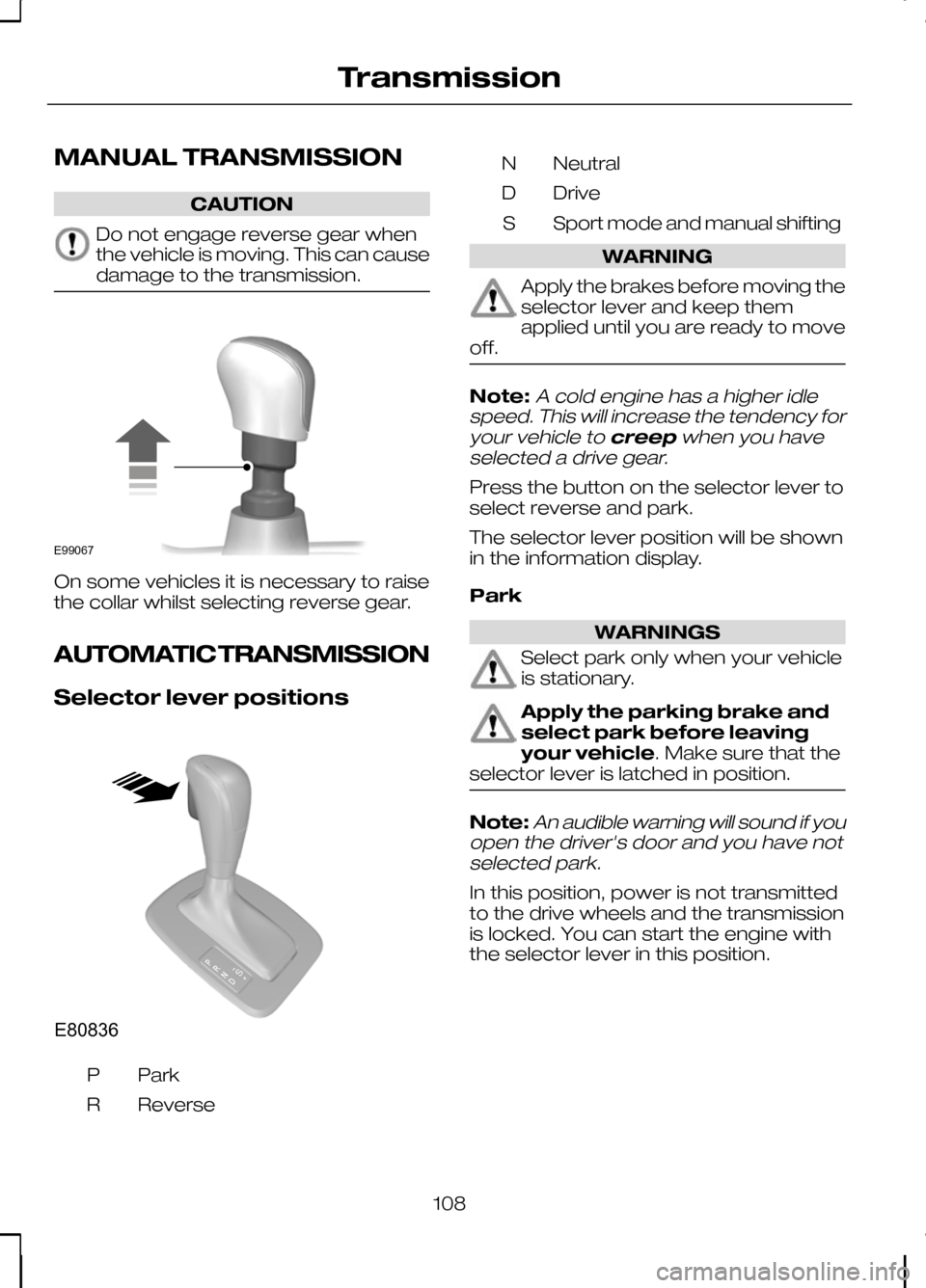
MANUAL TRANSMISSION
CAUTION
Do not engage reverse gear when
the vehicle is moving. This can cause
damage to the transmission.
On some vehicles it is necessary to raise
the collar whilst selecting reverse gear.
AUTOMATIC TRANSMISSION
Selector lever positions
ParkP
Reverse
R Neutral
N
Drive
D
Sport mode and manual shifting
S WARNING
Apply the brakes before moving the
selector lever and keep them
applied until you are ready to move
off. Note:A cold engine has a higher idle
speed. This will increase the tendency for
your vehicle to creepwhen you have
selected a drive gear.
Press the button on the selector lever to
select reverse and park.
The selector lever position will be shown
in the information display.
Park WARNINGS
Select park only when your vehicle
is stationary.
Apply the parking brake and
select park before leaving
your vehicle. Make sure that the
selector lever is latched in position. Note:
An audible warning will sound if you
open the driver's door and you have not selected park.
In this position, power is not transmitted
to the drive wheels and the transmission
is locked. You can start the engine with
the selector lever in this position.
108
TransmissionE99067 E80836S